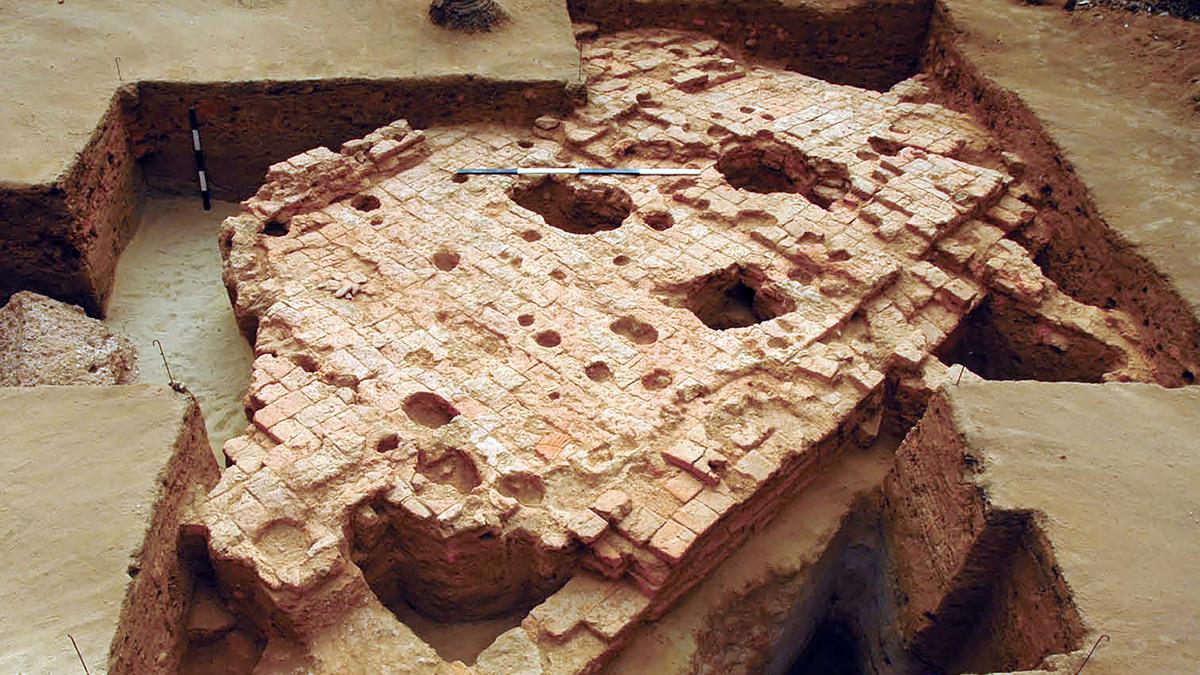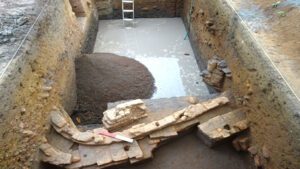(Disclaimer: The headline, subheads, and intro of this report along with the photos may have been reworked by South First. The rest of the content is from a syndicated feed, and has been edited for style.)
Historians consider the city of Pattanam to have played an instrumental role in trade and cultural exchanges between India and Middle East.

A brick platform near the wharf complex at Pattanam.
Recent evidence from the archaeological site at Pattanam — on the south-western coast of India in Kerala’s Ernakulam district — and their ancient DNA analyses strengthen the belief of historians that Pattanam played an “instrumental role” in trade and cultural exchanges, scientists have said.
The archaeological site at Pattanam is believed to be part of the ancient port city of Muziris.

Site of the Pattanam excavation. (Department of Tourism, Kerala)
Historians consider the city of Pattanam to have played an instrumental role in trade and cultural exchanges between India and West Asia, North Africa and the Mediterranean regions.
The belief stems from the classical Greco-Roman records, as well as Tamil and Sanskrit sources.
“The recent and more conclusive archaeological evidences from Pattanam, and their ancient DNA analyses — led by chief scientist at CSIR-Centre for Cellular and Molecular Biology (CCMB) Kumarasamy Thangaraj and PJ Cherian — strengthen the belief, and is now published in the journal Genes,” the Hyderabad-based CCMB said in a press release.
At the Pattanam archaeological site, scientists and archaeologists have found, among others, human bones, storage jars, a gold ornament, glass beads, stone beads, utilitarian objects made of stone, copper and iron, pottery, early Chera coins, a brick wall, and a six-metre-long wooden canoe parallel to the wharf structure, about 2.5 m below surface level, the release said.
“These structures indicate a vast ‘urban’ settlement. The excavations suggest that the site was first occupied by the indigenous Megalithic (Iron Age) people, followed by the Roman contact in the early historic period. It appears that the site was continuously occupied at least from 2nd century BCE to 10th century CE,” said Cherian, who is with the PAMA Institute for the Advancement of Transdisciplinary Archaeological Sciences, Ernakulam, Kerala.
Scientists used the DNA from the human skeletons to pinpoint the genetic ancestry of the people found in the region.
Niraj Rai, co-corresponding author of the paper, and a senior scientist with DST-Birbal Sahni Institute of Palaeosciences, Lucknow, said, “We have analysed the mitochondrial DNA of 12 ancient skeletal samples. We found that these samples show the presence of both South Asian and West Eurasian-specific lineages.”
The harsh climatic conditions of India are not always favourable to ancient DNA research.
“Most of the excavated skeletal remains from the Pattanam site were in a very fragile state due to the tropical, humid, and acidic soil conditions. However, we have adopted the best practices in the field of ancient DNA analysis and successfully analysed the samples,” said Kumarasamy Thangaraj.
“The unique imprint of West Eurasian and Mediterranean signatures found in these samples exemplify a continuous inflow of traders and multicultural mixing in ancient South India,” Thangaraj added.
“This is the first genetic data generated, so far, to infer their origin and genetic makeup of the Pattanam archaeological site. And the findings reinforce the early historical occupation of culturally, religiously, and ethnically diverse groups at the Pattanam archaeological site,” said Vinay Kumar Nandicoori, Director, CCMB.
(Disclaimer: The headline, subheads, and intro of this report along with the photos may have been reworked by South First. The rest of the content is from a syndicated feed, and has been edited for style.)

May 01, 2024

Apr 28, 2024

Apr 25, 2024

Apr 25, 2024

Apr 24, 2024

Apr 24, 2024